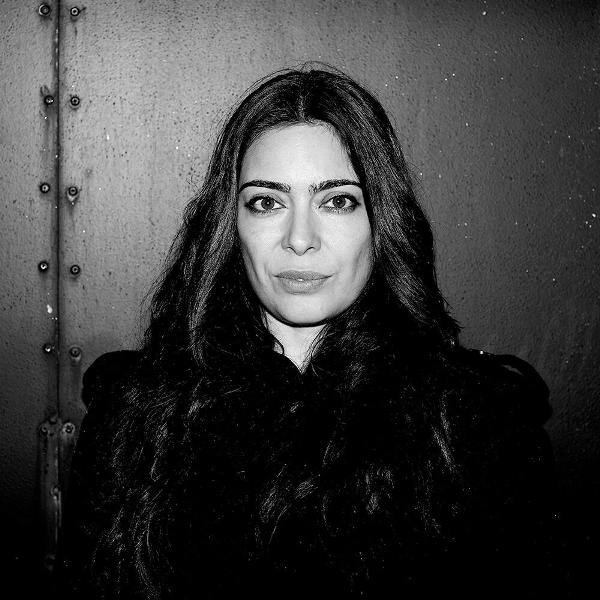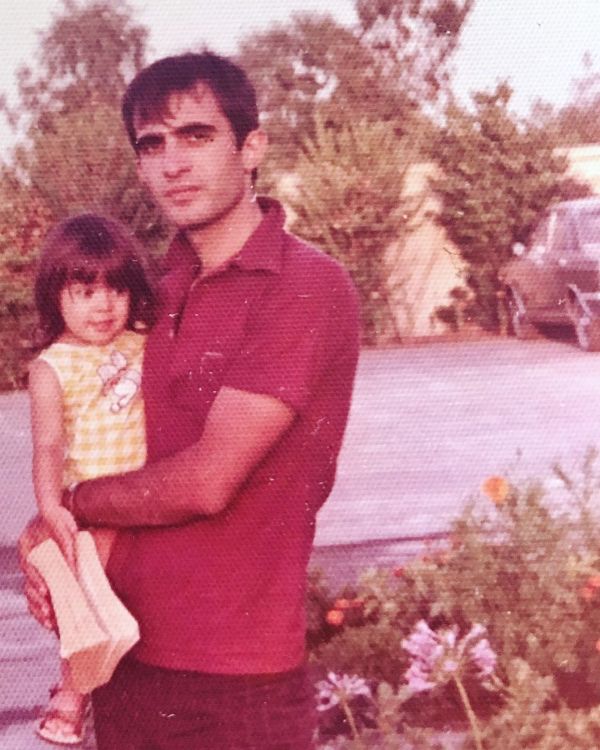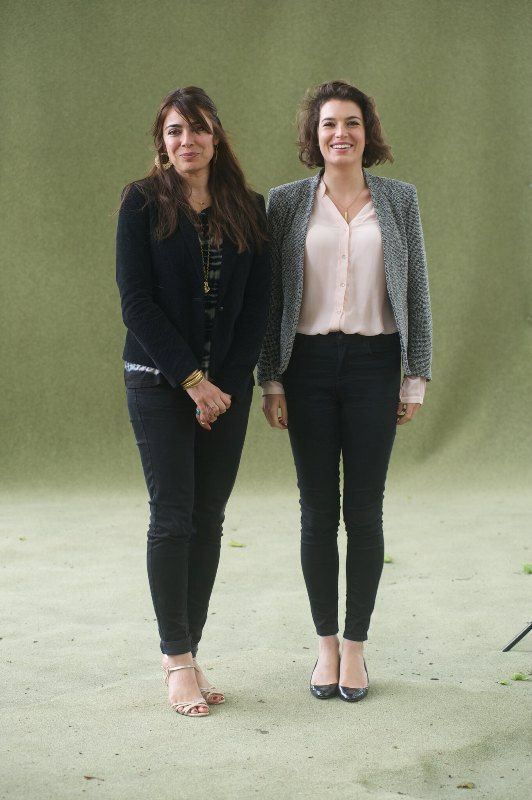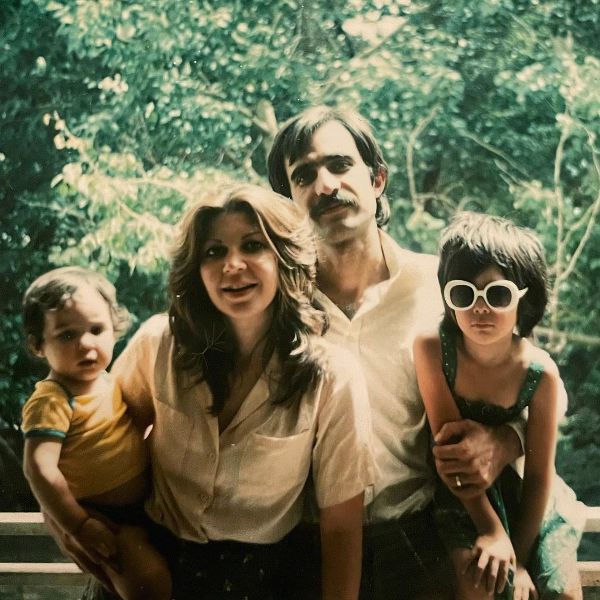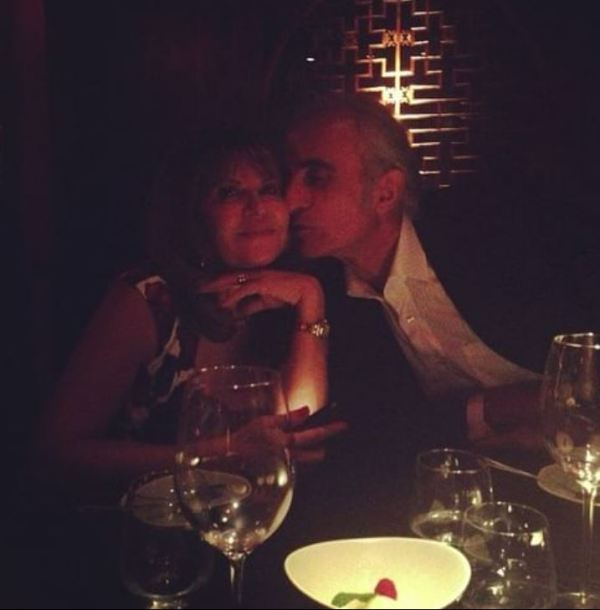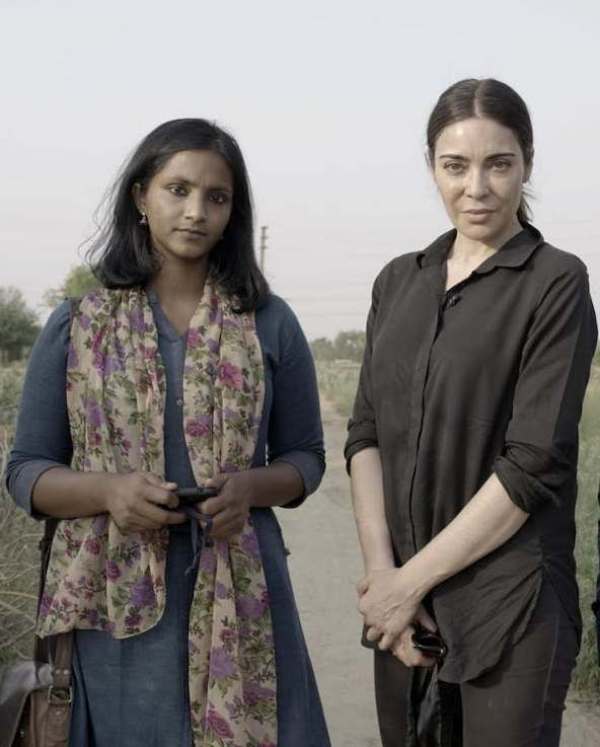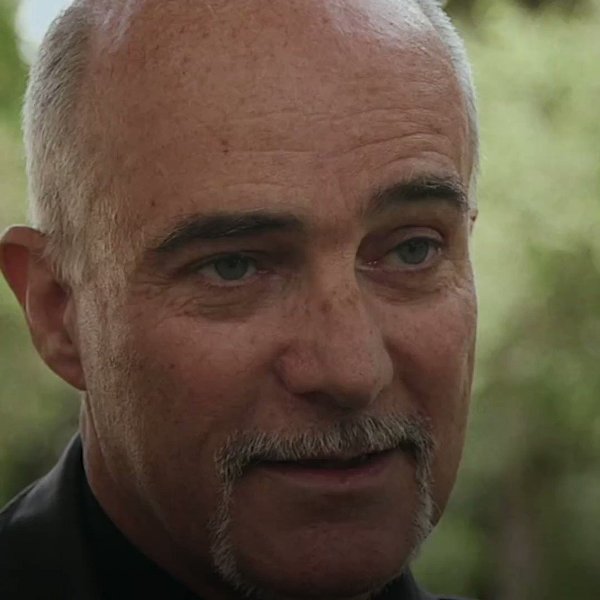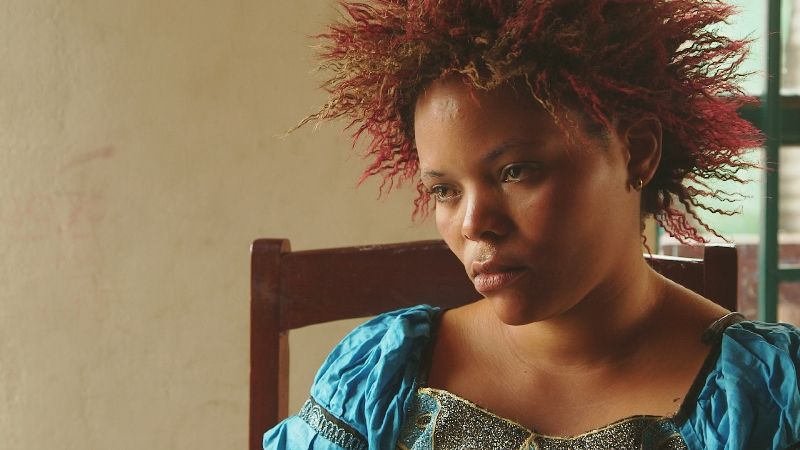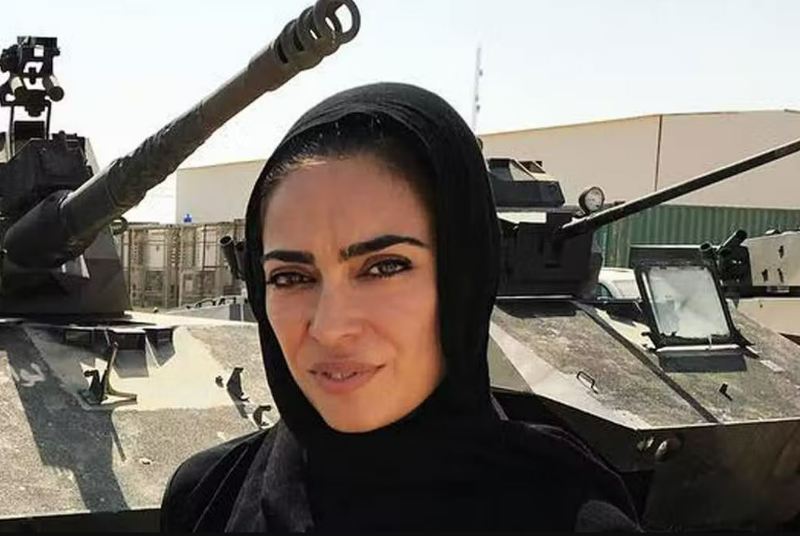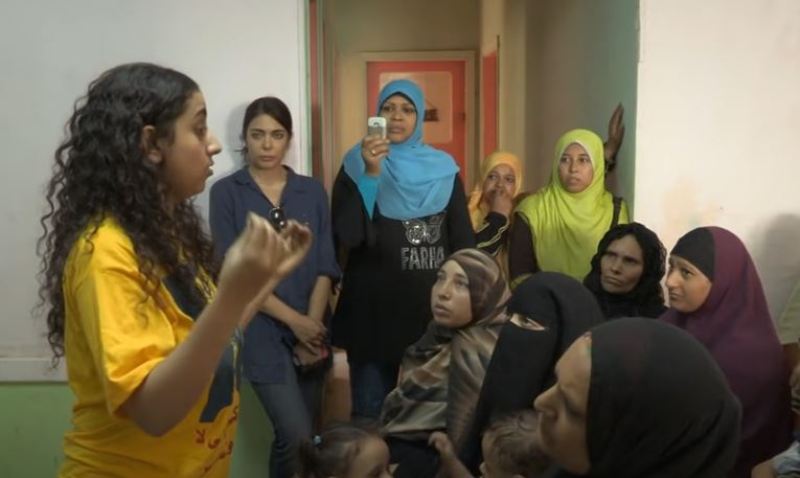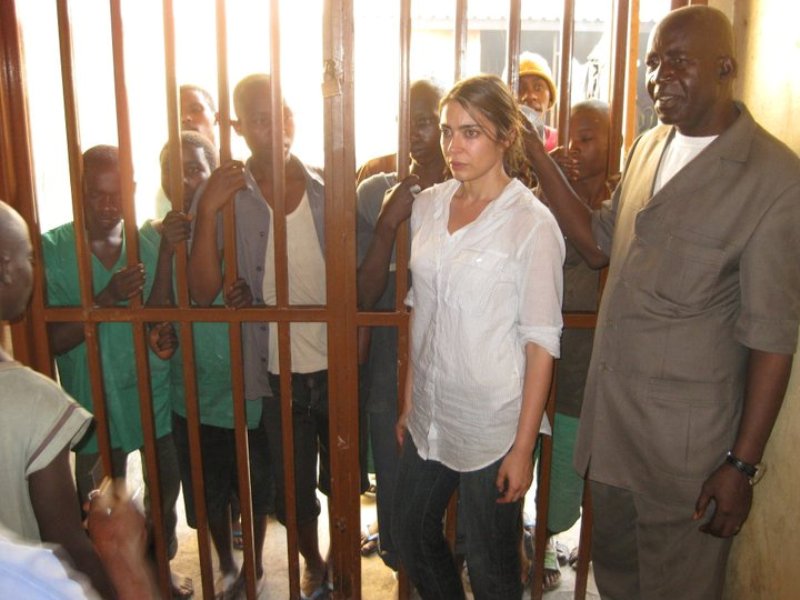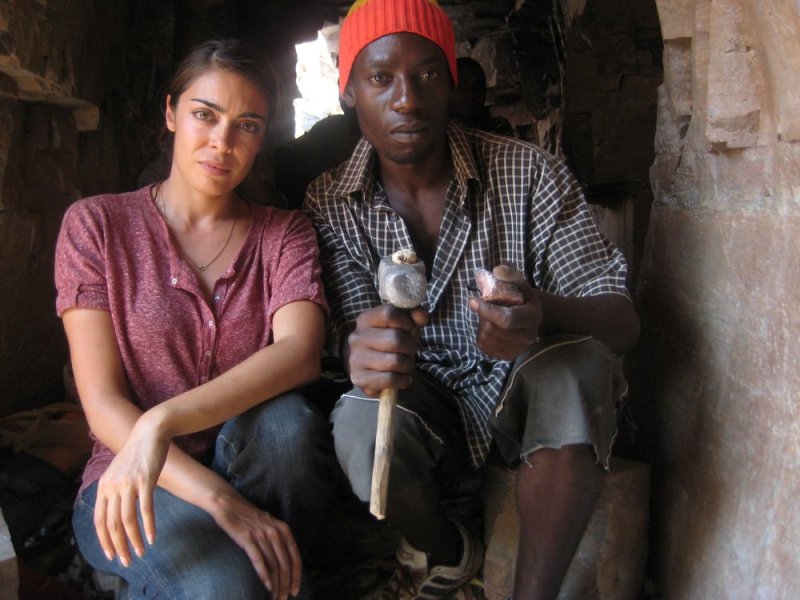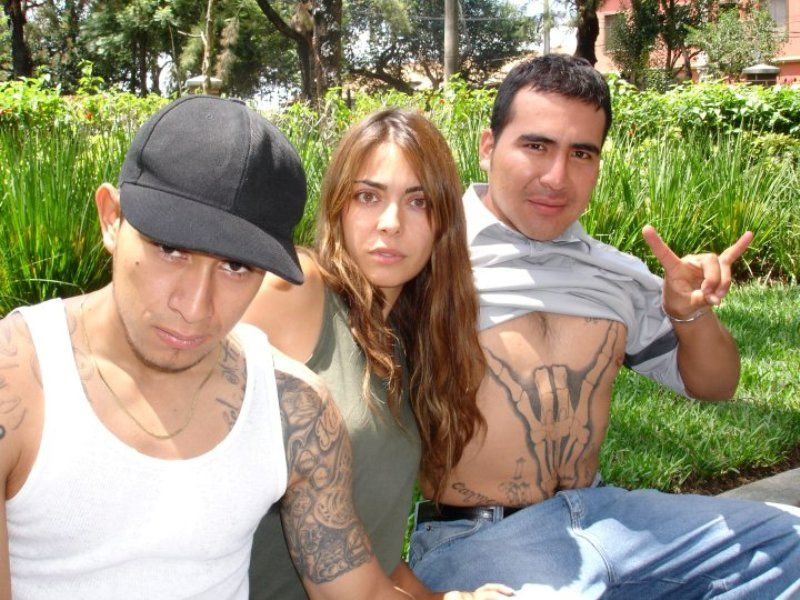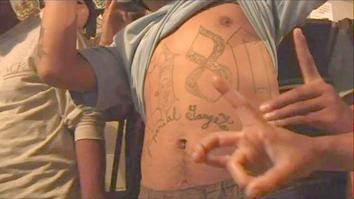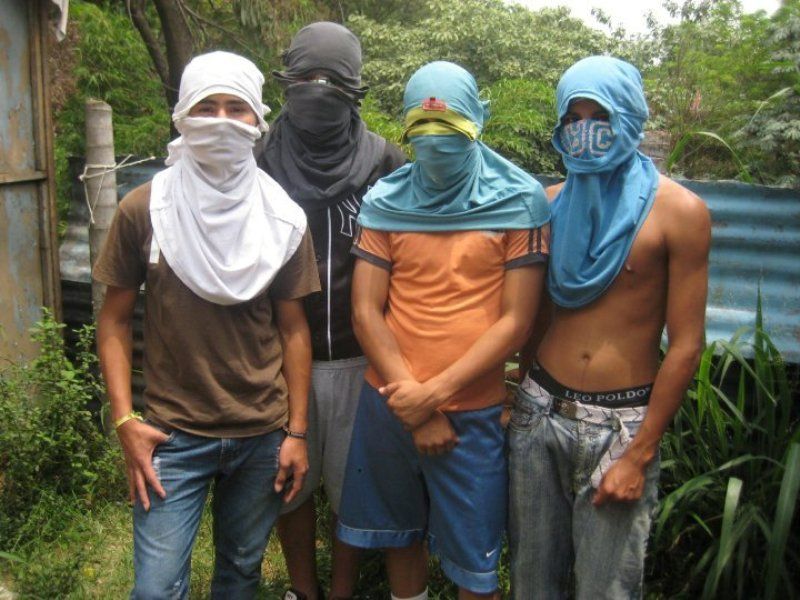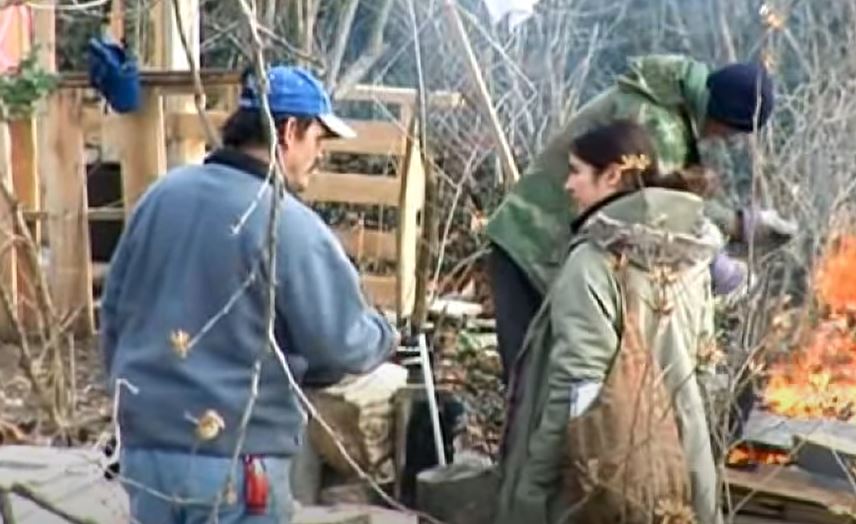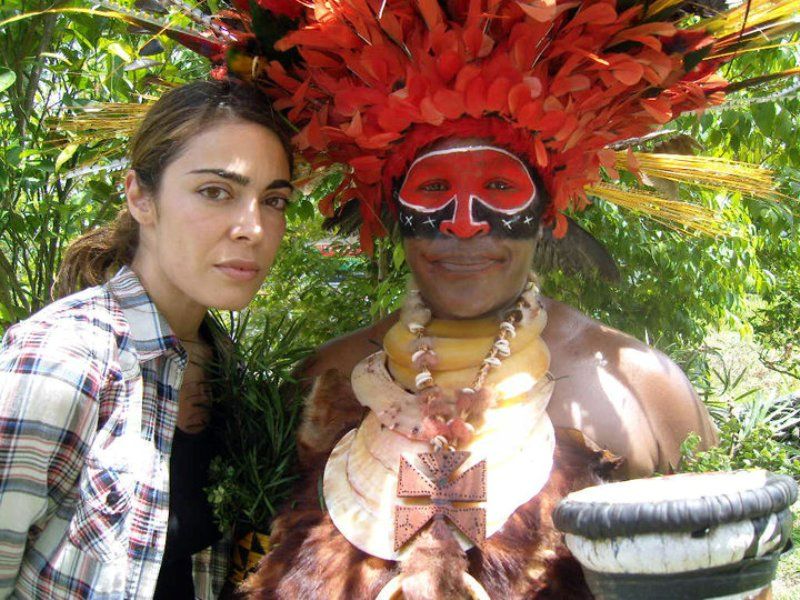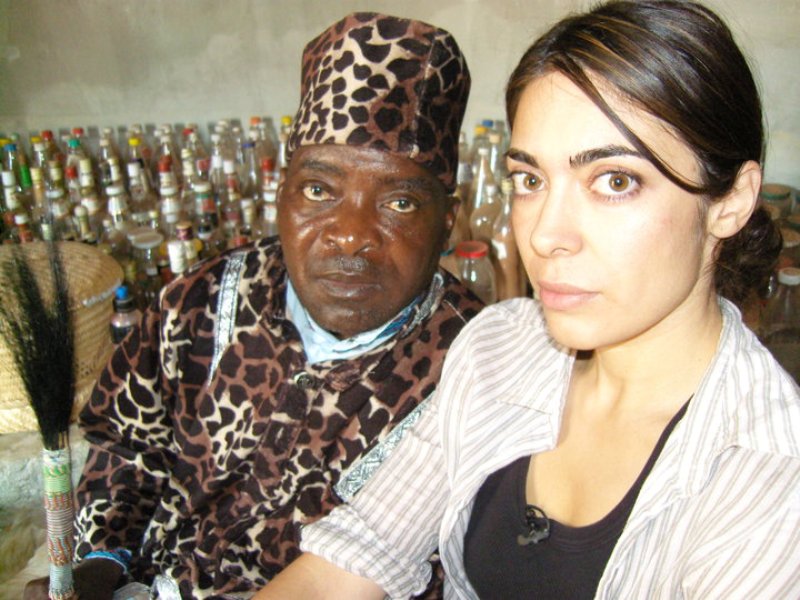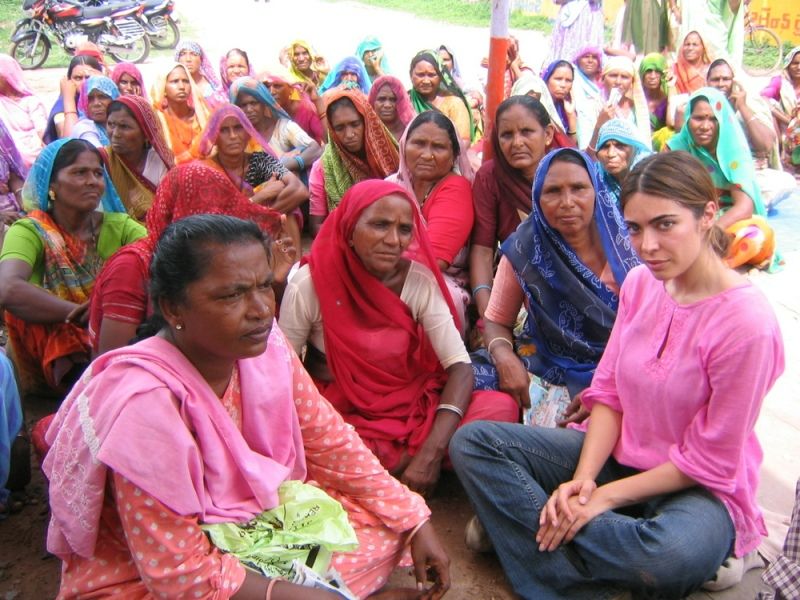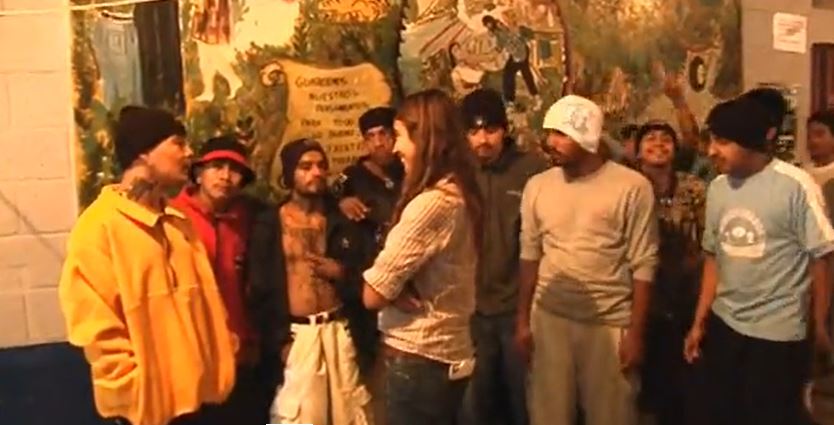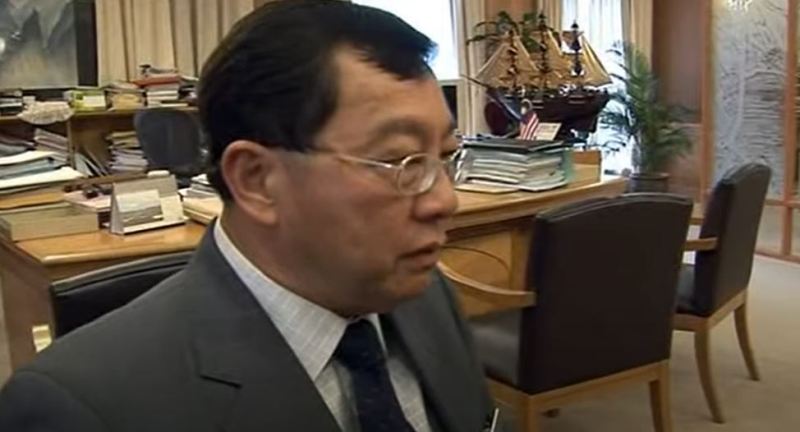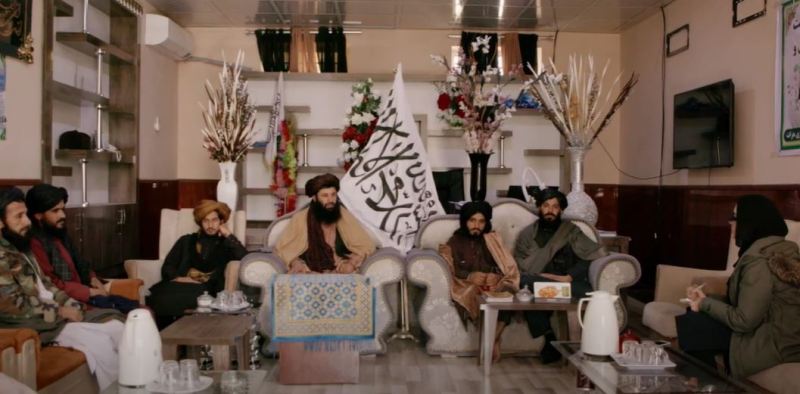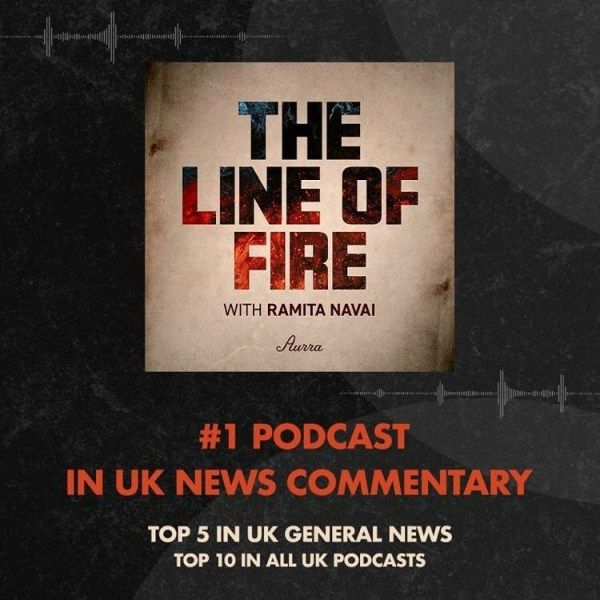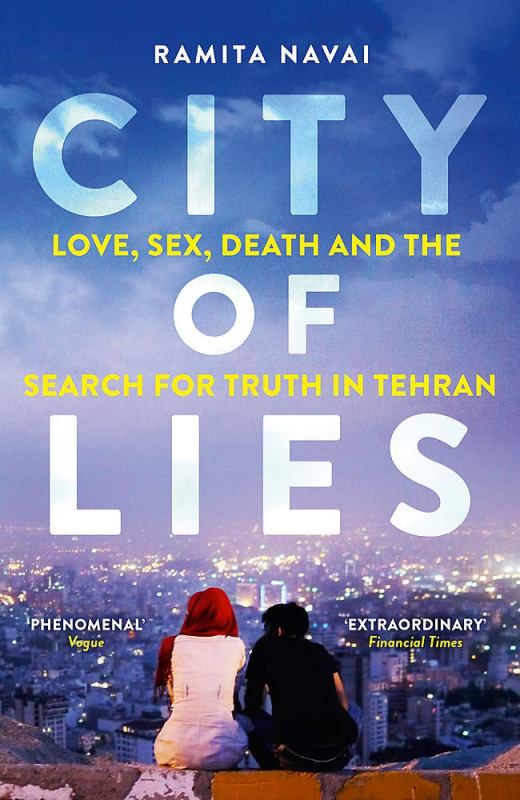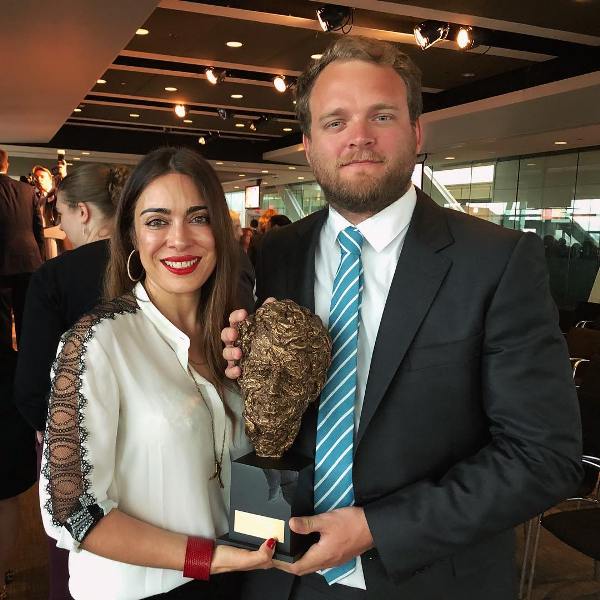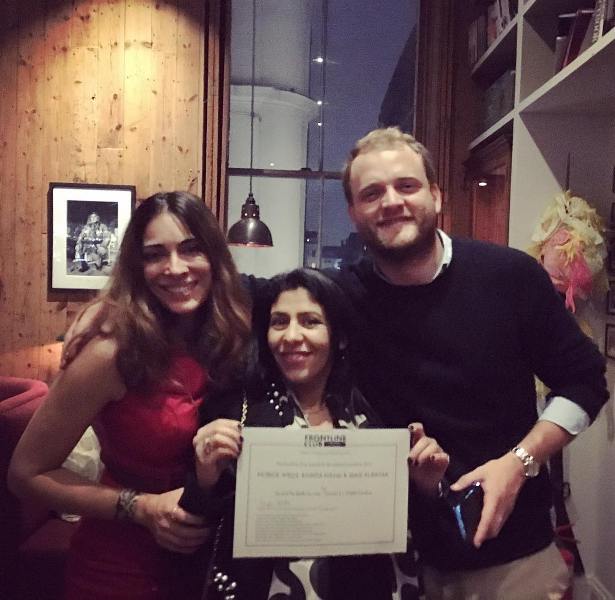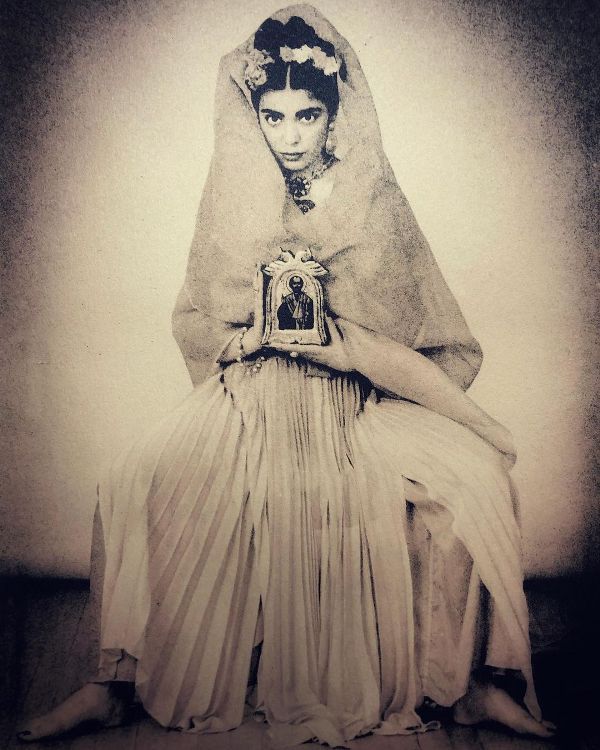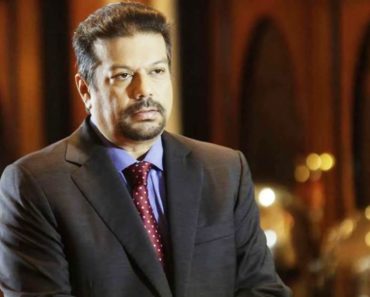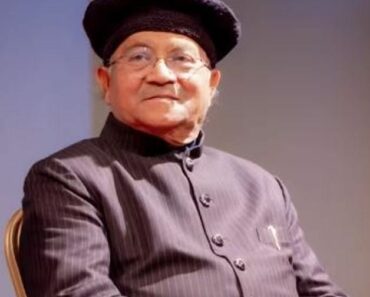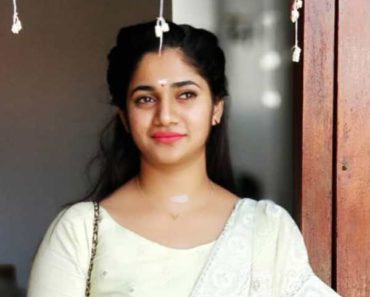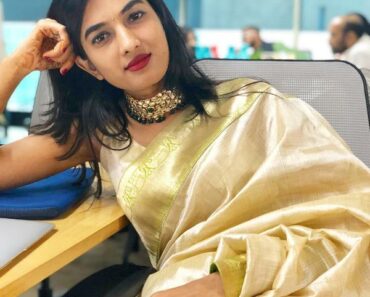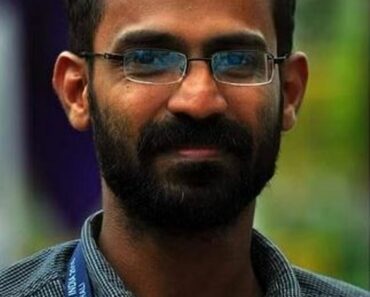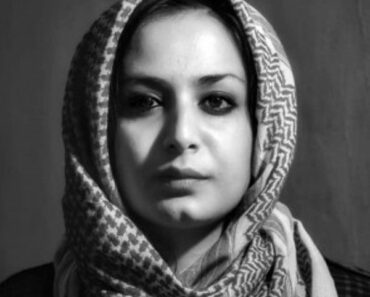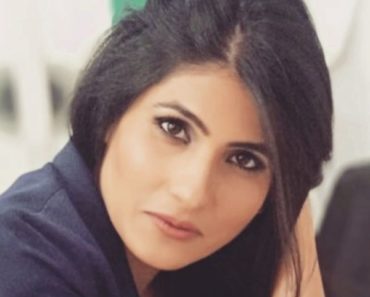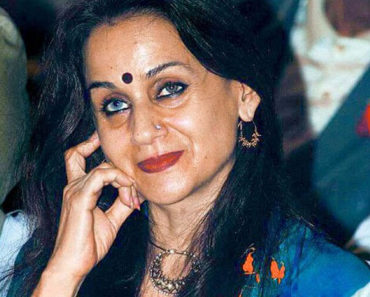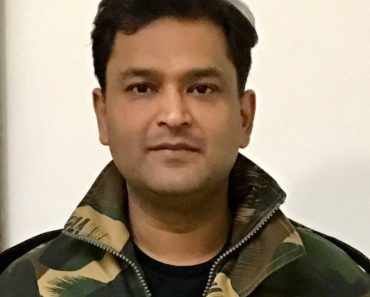Ramita Navai is a British-Iranian investigative journalist, documentary maker, and author who investigates and covers stories from the hostile environments of countries in the world. Reportedly, she has reported from over forty countries. [1]Ramita Navai Ramita is renowned for her investigative documentaries, revealing the truth behind high-level crimes. Ramita Navai not only covers the news but makes documentaries that require investigations over a long period, and this is what makes her different from other journalists. Ramita’s documentaries are investigative reports, which represent ‘the story behind the story. ‘
Contents
Wiki/Biography
Ramita Navai was born on Saturday, 21 July 1973 (age 49 years; as of 2022) in Tehran, Iran. Ramita grew up in London, United Kingdom, where she completed her formal education. [2]World Affairs
Ramita pursued a master’s degree in journalism at the City, University of London. [3]Ramita Navai While pursuing her master’s degree in London, Ramita made a documentary film on transsexual legislation in the UK that won her the National Young Broadcast Journalist of the Year award. [4]Ramita Navai According to Ramita, after her post-graduation, she wanted to become a foreign correspondent. [5]World Affairs According to Ramita, after her post-graduation, she wanted to become a foreign correspondent, and she wanted to start her journalism career in Iran. [6]World Affairs In an interview, Ramita shared that her motivation to choose and work in this field was to expose outlaws. In an interview, she said,
My motivations were mainly exposing the baddies and they are still there today so exposing corruption and abuse at any level, particularly at a high level, that gives me a kick.” [7]Aurra Studios – YouTube
Physical Appearance
Height (approx.): 5′ 6″
Hair Colour: Medium Brown
Eye Colour: Brown
Family
Ramita Navai belongs to an Iranian family.
Parents & Siblings
Ramita’s father’s name is Kourosh Navai (deceased), and her mother’s name is Laya Navai. [8]Evening Standard Ramita has a younger brother, Ramin Navai, who was appointed as British Ambassador to Paraguay in October 2020. [9]Ramin Navai – Twitter
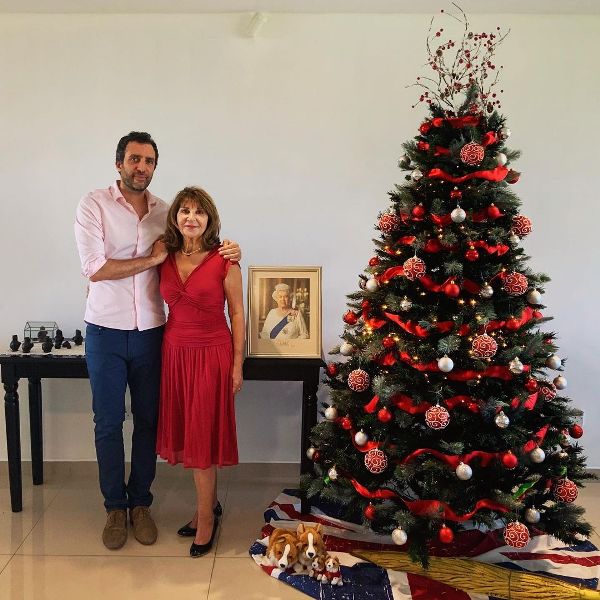
Picture of Ramita’s younger brother Ramin Navai, the Ambassador to Paraguay with mother Laya Navai – clicked at Asunción, Paraguay on the eve of Christmas
Husband & Children
Ramita Navai is not married.
Career
Reporter
In 2003, Ramita Navai joined ‘The Times’ in London, [10]Jaipur Literature Festival – YouTube in the United Kingdom as Tehran Correspondent for three years. [11]LinkedIn She has written numerous articles for many renowned media platforms including The Sunday Times, Literary Review, The New Statesman, The Spectator, The Washington Post, The Guardian, The Times, The World Today, The Independent, The Irish Times, Christian Science Monitor, Marie Clarie, National Geographic Traveller, The Huffington Post, and many more. [12]Ramita Navai
Channel 4
In 2006, she joined ‘Channel 4’ and worked as a reporter for a foreign’s affair program, Unreported World, an ITN Production. [13]Ramita Navai Reportedly, she has reported and produced over twenty documentaries. [14]Ramita Navai
India’s Rape Scandal Dispatches
Ramita investigated the sexual assault cases in India with a team of journalists including Nidhi Suresh, an Indian journalist. The documentary turns every chapter of covered-up rape cases, particularly those in which powerful personalities were involved in committing the crime. The documentary covers the stories of two teenage girls, Jaya, who was raped by a member of the BJP named Kuldeep Singh Sengar, and Manisha, a 19-year-old girl from Uttar Pradesh, India, who died in a hospital a week after the gang rape, and her parents refused to attend her cremation. The cases are known as the ‘Unnao rape case’ and ‘Hathras case‘ respectively.
In 2021, in an interview, Ramita Navai shared her thoughts about the escalation of sexual offences after she had a word with some journalists in India about the censoring of rape cases in the country by the government. She said,
I spoke to so many journalists who have been threatened over covering stories about rape. This is where it gets interesting: why would the government want to censor rape stories? The number of rapes under Modi’s rule have actually increased since his pledge – that’s why they try to shut down these stories before they become public.” [15]Stylist
In 2021, in an interview, Ramita expressed the aim of making this documentary and referred to it as a documentary with a perspective of bringing change in the system and justice to the victims. She said,
It’s about the systemic coverup in this country. I want people to want serious change and to scrutinise after watching it. People need to be angry, shout about it and get justice for these women.” [16]Stylist
The UN Sex Abuse Scandal Dispatches
Ramita Navai highlighted over 1700 allegations of sexual exploitation against the UN peacekeepers for more than 15 years in this documentary. She brought a case of a victim, Valerie, to the United Nations. Reportedly, Valerie was a victim of an infamous sexual abuser and the former UN peacekeeper Didier Bourguet. [17]Channel 4 News Reportedly, he worked in the world’s largest UN peacekeeping mission. [18]Channel 4 News According to Ramita Navai, Didier Bourguet used to find girls to have sexual relations through middlemen. Ramita highlighted the UN sex abuse scandal in this documentary through various interviews. In an interview, Bourguet told Ramita that he had sexual relations with around 25 girls between the age of 12-16 years in Congo, a country in Central Africa. In an interview, when Didier Bourguet was asked about the reason for those sexual assaults, he said,
Of course, they were starving so that’s why. It’s easy.” [19]Channel 4 News
In the interview, Bourguet said that he was somewhat aware that whatever he did was wrong but had no guilt for his actions. [20]Channel 4 News Reportedly, in 2008, Bourguet was charged with raping over 20 young girls in Congo and possessing hundreds of child pornographic images. [21]Channel 4 News According to the media, he was also sentenced to nine years in prison for raping two minor girls. [22]Channel 4 News In another interview, Valerie recalled the incident of being sexually assaulted by Didier Bourguet right from the moment when she was first spotted by Bourguet. Valerie said,
He’d pass when I was selling bananas. When he told me that he loved me, he took me to Hotel Linda. I felt very bad because he was my father’s age. The first time he gave me $2. The second time he gave me $5. Another time $15.” [23]Channel 4 News
The documentary was nominated for an ‘Emmy Award’ [24]Ramita Navai – LinkedIn and the ‘Grierson Awards,’ [25]Ramita Navai – LinkedIn given to appreciate innovative and exciting documentary films – set up by The Grierson Trust.
ISIS and the Battle of Iraq Dispatches
Ramita Navai, Patrick Wells, and Mais Al-Bayaa made a dangerous walk inside Iraq to investigate the threats from Shia militia fighters to Sunni refugees.
Migrant Crises: Tracking Down the Kidnap Gangs
Ramita Navai tracked down a house patrolled by armed guards 24 hours a day in Macedonia, where hundreds of migrants were kept as a source of ransom money. Mohammad and Ahmad, two of those migrants who were kidnapped from the border area between Greece and Macedonia, escaped the house luckily. They contacted Ramita and shared a video (secretly recorded) in which migrants were being asked for money for their release. According to Ramita, the kidnappers would only let people go if they pay them a ransom of a thousand euros each. [26]Channel 4 News According to Ramita, she visited that house with the help of the information shared by Mohammad and Ahmad and discovered that the kidnappers were being controlled by their leader named Alibaba. Reportedly, the guards did not let Ramita near the house, and it was found that the government officials were also involved in helping human traffickers and kidnappers. [27]Channel 4 News The documentary was nominated for ‘Rory Peck Award’ and ‘Amnesty International Media Award (TV News).’ [28]Ramita Navai – LinkedIn

A still from the investigation where Ramita Navai was talking to one of the kidnappers at the house in Macedonia where hundreds of migrants were held along with Mohammad and Ahmed
Unreported World, Egypt: Sex Mobs and Revolution
Ramita Navai and director Dimitri Collingridge travelled to Egypt to examine the sexual assaults on women by young men who were being paid for the same. It was revealed that there were three big groups of men who would attack girls and not only harass them but also torture them. Ramita and the team interviewed many victims of such mob attacks. According to Ramita, many women in Egypt were living in the guise of men to avoid being harassed. [29]Unreported World The victims revealed that women were not allowed to wear make-up and go outside the house without their heads and hair covered fully. One of the women who were interviewed said that she was refused to be protected from a mob attack by a police officer because she was wearing make-up and was out without her hair covered. [30]Unreported World While documenting the matter in the streets of Egypt, Ramita interviewed a woman in a niqab who said that the attacks had nothing to do with their looks and uncovered body. She shared her story of being pulled aside and harassed by a group of men even when she was covered completely in the niqab. [31]Unreported World Ramita also tried to talk to some young men involved in mob attacks to get a more clear vision of their perspectives. While covering a protest by a group of women, asking for dignity and safety, Ramita and Dimitri were able to capture a man sharing his thoughts on the same. He said that he was against women wearing make-up because it could make men of all ages attracted to them. He said,
I am against women who say ‘don’t harass me’ and then wearing things that arouse young men even an old man of sixty would be turned on by a woman dressed indisputably. And then she stands here and says no to harassment when she is actually wearing things that stimulate men’s desire.” [32]Unreported World
The group of protesters also invited Ramita and the team to a house located in an impoverished neighbourhood in Cairo, where they were living in disguise. [33]Unreported World The entry of men was restricted in the holding house. According to Ramita, the women in the house were from different backgrounds but were sharing the same experiences. [34]Unreported World
A man, whom Ramita and the team met while investigating the matter, revealed that he was being paid by the people of high ranks to attack women if they tried to give an opinion about anything during elections. He also added that those people just wanted disorder in the country. [35]Unreported World In 2013, the documentary was nominated for the ‘One World Award,’ [36]Ramita Navai – LinkedIn an award for journalists and filmmakers for their efforts to connect people from unreported stories in different parts of the world. The documentary has also been nominated for the ‘Foreign Press Association Award.’ [37]Ramita Navai – LinkedIn
Unreported World, Honduras: The Lost Girls
Correspondent Ramita Navai and director Talya Tibbon covered the inexplicable missing of women in Honduras, a country in Central America. Ramita and the team discovered that the Honduran women were first attracted to false promises of providing decent jobs in Mexico by agents, and they eventually became victims of human trafficking. The team met a group of women who had set up a team themselves to track their daughters after observing the lethargic behaviour of the administration.
Ramita and Talya were set up for a meeting with a man who was involved in human trafficking on the condition of anonymity. According to Ramita, the man was initially involved in smuggling drugs but was later made a recruiter (agent) by his boss. [38]Unreported World In the interview, the man disclosed how he used to trick innocent girls and managed to sell each girl for $100. [39]Unreported World According to Ramita, the man sold around forty girls when he was an active trafficker. [40]Unreported World He said,
Mainly in squares, in shopping centres. You would chat with them, trick them and offer money for a decent job for example cleaning a house or looking after a lady. When they arrived it was a different situation.” [41]Unreported World
Unreported World: Breaking into Israel
Ramita Navai and director Paul Kittel travelled through Egypt’s Sinai desert to visit some African migrants in a safe house who were being tortured and asked for ransoms by the smugglers. Reportedly, the smugglers were engaged in transferring refugees from Eritrea into Israel via Sudan and Egypt. The documentary was nominated for ‘The Immigration Journalism Prize of the French-American Foundation.’ [42]Ramita Navai – LinkedIn
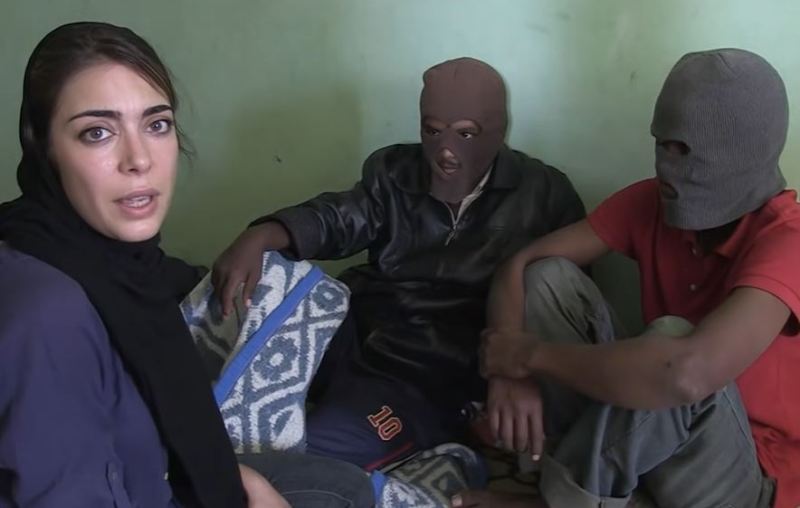
A glimpse of the secretive investigative reporting from a holding house (secret) in Egypt – Ramita talking to two of the migrants who were in the trap of the smugglers for more than a month
Unreported world, Burundi: Boys Behind Bars
Ramita Navai travelled to a country in east-central Africa, Burundi, where nearly 400 children were locked in prisons among adult criminals without trials, and provided with one meal a day. Ramita and director Wael Dabbous went for an inspection of prisons with Pierre-Claver Mbonimpa, a man who spotted a dead body of a child in the jail premises while he was lodged in prison, and since then, he decided to stand in the fight for justice for those children. [43]Ramita Navai According to Ramita, children as young as below the age of 15 could be seen there. While interviewing those children, Ramita found that children were being sexually abused by the adult prisoners, and the reasons for which they were kept there were absurd. One of those children told Ramita that he was left there by his family because they didn’t like him. The prisoners shared that being trapped in the prison with no exposure to the outside world had damaged them mentally. In 2012, the documentary was shortlisted for the One World Media Award.’ [44]Ramita Navai – LinkedIn
According to Ramita, the law of the country was affected by the civil war, and the country had nearly 106 lawyers for around 80 million population. Reportedly, Ramita visited a prison in Pember, where women were living with around 3000 men as there was no separate block for women. While interviewing women in Pember, Ramita got to know that women in Pember were forced to get physically involved with men to survive in prison, where they eventually became pregnant. It was also revealed through the documentary that children were also being forced to sleep with adults to survive in the prison.
Unreported World, Zimbabwe’s Blood Diamonds
Reportedly, Ramita Navai and director Alex Nott went undercover as tourists to find out more about the diamond trade in Zimbabwe and how these were smuggled over the border into a country in southeastern Africa, Mozambique. According to Ramita, it was claimed that the diamonds were illegally used by Robert Mugabe’s Zanu PF party.
Unreported World: Afghanistan’s Child Drug Addicts
The documentary brings light to drug abuse among children in Afghanistan, where Ramita and her team found that children were addicted to narcotic substances such as opium and heroin. Reporter Ramita and director Matt Haan came across the fact in the lives of children in Afghanistan that they accepted drugs as an escape from the hunger, pain, and psychological effects of war.
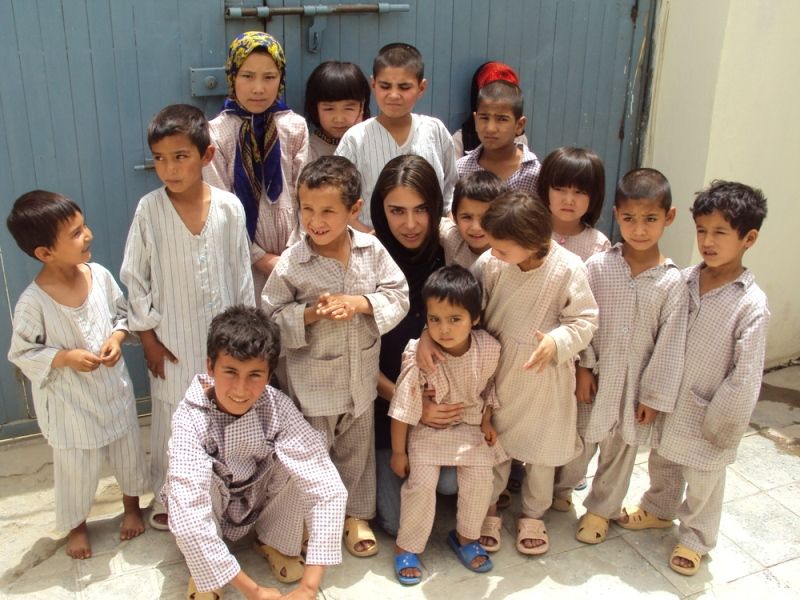
Ramita Navai with the children who were recovering from drug addiction (mainly heroin and opium) at the Sanga Amaj rehab clinic in Kabul
Unreported World, El Salvador: The Child Assassins
Ramita Navai and Alex Nott travelled to El Salvador, a country in Central America which was reportedly trapped in gang violence for more than decades. Reportedly, the gangs in El Salvador were changing their methods of operation by using children to kill. Ramita Navai met some of the children involved in the killings. The two of the children she met were assigned the task of identifying the enemy and killing them. According to Ramita, children below the age of twelve could be seen as killers and victims in El Salvador. Ramita and Alex, along with police officers, went to San Salvador, the capital of El Salvador, where they spotted a man covered in blood in the area called ‘The Gang’s focal point.’ They took him to the hospital, where police cars were used as ambulances because of the numerous gunshot victims that caused a shortage of ambulances. According to Ramita, the police were dealing with more than 10,000 gangs in the city. Reportedly, during the investigation, Ramita and Alex covered the cases, which were being informed to the police officials through a radio call. According to Ramita, there were two main rival gangs in the country namely ’18 Street’ and ‘MS (Mara Salvatrucha) 13.’ [45]Ramita Navai The gang members had a tattoo of their respective gangs inked on their bodies as their identity.
Reportedly, the police had locked up around 7000 gangsters in prison, but that couldn’t diminish the rate of murder in the country. According to Ramita, the government deployed around 4000 soldiers onto the streets who had given the power to stop and search people. According to Ramita, soldiers were concerned about the young gang members as the law of the country was too lenient for the children. Ramita also spotted some signs and marks of gangs on the wall of the streets conveying some message to the people who lived there. According to Ramita, she met some of the boys who were asked and forced to join the gang. According to one of those boys, he was beaten so badly that his arm was broken, and he used to receive notes slid underneath the door saying if he wouldn’t join the gang he will be killed.
Reportedly, a European journalist was shot dead after filming with gang members in El Salvador. Since then, gang members had stopped talking to outsiders. Ramita and her team managed to set up a meeting with Dreama, the leader of the 18 Street gang; he joined the gang when he was 15 years old. According to Dreama, children of the age of twelve or younger were believed to be active in murdering as it had become a competition for them who would kill more people. Ramita, along with her team, met some of the members of the 18 Street gang. According to Ramita, none of the gang members was worried about murdering or being killed, which made them look more dangerous. Ramita also cites financial reasons behind the children joining such street gangs as most of their family members were working in the United States which was hit by the recession at that time. Ramita and her team tried to discover more about the murders for which they visited the city’s morgue, where the doctor showed them pictures of the deceased women with some signs and marks engraved on their bodies before they were killed. According to Ramita, the murders with no shreds of evidence and terrified witnesses cases remained unsolved and almost all of them were unreported.
Unreported World, USA: Down and Out
In this documentary, Ramita Navai (reporter) and Clancy Chassay (producer) went for an investigation across the USA to talk to the victims of the outbreak of homelessness in the country because of small payments to the middle-class people due to which they had to live in their cars and tents.
Unreported World, South Sudan: How to Fuel a Famine
Reporter Ramita Navai, along with director Julie Noon, travelled to South Sudan, a country in northeastern Africa to investigate the targeted killing of women and children. Reportedly, in 2009, around 2000 people were killed. The team found out about the spilt families, the population on the edge of starvation, the malnourished children, and the increasing cases of child theft or child abduction.
Unreported World, Peru: Blood and Oil
Ramita Navai and director Alex Nott travelled into the Peruvian jungle located in Peru to investigate the violent clash between the tribal people and the Peruvian government because of auctioning off of a vast area of the Amazon rainforest to global corporations by the government.
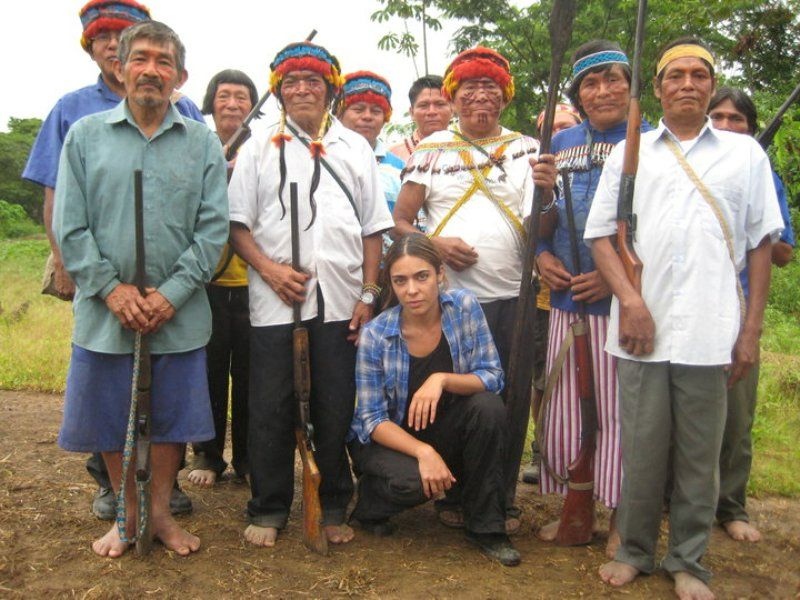
Ramita Navai with the tribesmen in the remote village of Washintsa, in the Pastaza river basin, and people from the neighbourhood to save their lands from being bought by the global corporations
Unreported World, Papua New Guinea: Bush Knives and Black Magic
The documentary is about the investigation in Papua New Guinea, a country with immense culture and biodiversity in Oceania, which includes the regions of the island between Asia and America. Ramita Navai investigated the prevailing murders of “witches.” [46]Quicksilver Media Reportedly, almost fifty women were stoned, burnt at a stake, slashed, and even buried alive because they were accused of being witches and performing witchcraft; however, the killers or “witch-hunters” were rarely punished. While investigating the matter, Ramita Navai, along with director, Katherine Churcher, met the victims, the witch-hunters, and the police officials. As per the reports, Ramita and the team managed to track Geoffrey, [47]NosAmaMatre – Youtube one of the witch-hunters who revealed that he could spot a witch by observing changes in a person’s behaviour. He once believed that one of his relatives had an evil spirit inside her, and to protect the village, Geoffrey attacked her. According to Ramita Navai, she was told by people that “witch doctors,” a community of witches that practised good witchcraft were able to identify the witches. Ramita and Katherine met one of those witch doctors whose identity was kept confidential. In the interview, she shared that she was attacked by people and was spared because they thought that she would help track down other witches in the village. [48]NosAmaMatre – Youtube During the investigation, it was found that the killings which started from the remote highland were reaching towards the towns.
Unreported World, Turkey: Killing for Honour
Ramita Navai, along with producer-director Matt Han, [49]Quicksilver Media went to south-eastern Turkey [50]Quicksilver Media to document the “honour killing,” the murder or killing of an individual (especially a girl or woman) who has brought shame or dishonour to the family’s prestige. According to the media, Ramita reported the killing of almost 200 girls in honour killing, which included the killings of women even for standing close to an unmarried man. [51]Quicksilver Media According to Ramita, the new law which stated honour killing as an illegal act increased forced suicides of women.
Unreported World, Nigeria: Child Brides, Broken Lives
This documentary took the viewers to an unseen part of Nigeria, a country on the western coast of Africa. The documentary focused on the frightening repercussions of child marriage and girls becoming pregnant at a young age. Reportedly, in most of the states in northern Nigeria, the law regarding the age of marriage was not followed, and it was observed that the marriage of girls at a young age was acceptable, especially in Islam. During the investigative reporting, a cleric who was interviewed was obdurate that a man should be allowed to marry a young girl, but the same man was of the opinion that young girls should be saved from becoming pregnant at a young age.
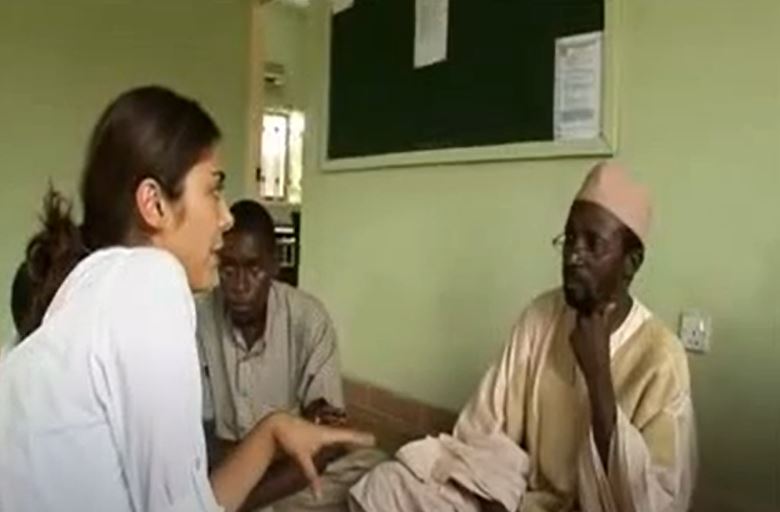
Ramita with the obdurate cleric in favour of the marriage of young girls but against young pregnancy
Unreported World, South Africa: Body Parts for Sale
In this documentary, Ramita covered the horrifying truth of the killing of hundreds of people for their body parts to be used in the process of making traditional medicine. During the investigation, Ramita met a man who admitted the torturing and killing of people as one of the parts of his job.
Unreported World, Bangladesh: The Drowning Country
In this documentary, Ramita Navai (reporter), along with producer Andy Wells, reported the condition of a village after the increase in water level and the massive flooding in Bangladesh, a South Asian country. According to Ramita, the village was drowned in the flooded water, and the children had to use boats to reach their school. [52]Quicksilver Media
Unreported World, Chongqing: Invisible City
Reporter Ramita Navai and producer Nick Sturdee went to Chongqing, a municipality in China for which the Chinese government had spent around £114 billion [53]Quicksilver Media to turn it into ‘China’s version of Chicago.’ [54]Quicksilver Media Ramita and Nick spoke to the underprivileged farmers whose lands were snatched, commoners who were being expelled from their houses, and the exploited migrant workers. According to Ramita, the process of conversion of this municipality into an industrial and commercial hub was painful and disadvantageous for its people.
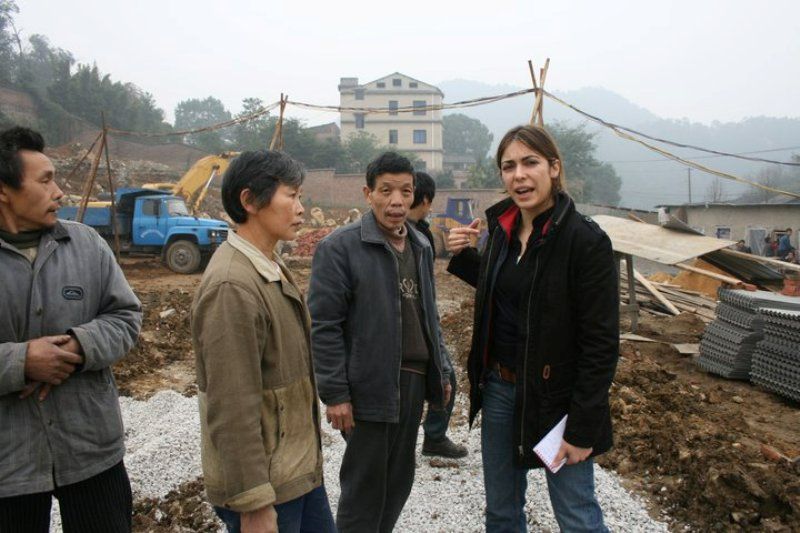
Ramita Navai with locals at Chongqing, China – reporting from the land which was used to be their farmland
Unreported World: India’s broken People
This documentary by Ramita Navai focuses on the victims of caste discrimination in India. While filming this documentary in Andhra Pradesh, India, Ramita Navai spotted a rally by Dalits (also called untouchables), a group which is considered at the bottom of the caste system hierarchy in Indian society. The protesters were demanding equal rights, respect, and opportunities. Ramita became familiar with the lifestyle and the types of jobs, determined by the individual’s caste, that they (Dalits) were supposed to do every day. Ramita met a Dalit woman who had been pushed out of the temple because she belonged to the lower caste. [55]Dailymotion Ramita watched Dalits performing their “duty” to clean the lavatories of the people from the upper caste manually [56]Quicksilver Media and also watched some people from the lower cast hunting rats to satisfy their hunger. [57]Dailymotion In 2009, the documentary was nominated for the Amnesty International Gaby Rado Award for Young Human Rights Reporter of the Year. [58]Ramita Navai – LinkedIn
Unreported World, Guatemala: City of the Dead
Reportedly, Ramita and her team investigated Guatemala city, the capital of Guatemala, a country in Central America. As per the report, the people in the city were living with the fear of getting killed anytime by street gangs. Reportedly, Ramita and her team were spotted and attacked by the members of the street gangs in the city. [59]Ramita Navai The gangsters would target commoners, the army, and police officials. According to Ramita, the sufferers had started fighting back for their freedom as a result of which the numbers of the gangs could be seen diminishing as the result. During the investigation, they spotted the dead bodies of a family of five members with their throats slit. Reportedly, the police officials referred to it as a ‘gang killing’ possibly for drugs or protection money. One of the police officials told Ramita that this was the first time he had seen a whole family killed brutally. Later, they were informed about another killing nearby. According to the police, the deceased was strangled to death. Ramita also visited the prison, where eighteen gangsters were locked up. Reportedly, those gang members had the privilege to decide who they want to meet in the prison. [60]Ramita Navai Ramita met the gang members who were enjoying the attention of the camera and spoke to them about the killings. After twenty minutes of the conversation, Ramita and her team were asked to leave the cell by the warden in charge. [61]Ramita Navai
After the meeting with gangsters at the prison, the team headed to a small city near Guatemala, Pauline, where they spotted vigilantes celebrating Guatemala’s independence. After the parade, they were taken through the empty streets of the city by one of the vigilantes. [62]Ramita Navai After the conversation with him and other vigilantes, Ramita found that the members of the committee ensured the protection of their people by setting up a curfew every night. [63]Ramita Navai During the process of investigation, Ramita discovered many attacks and heard about the stories behind them through people in Guatemala.
Unreported World, Malaysia: Asia’s Slaves
Ramita started her journey from the capital of Malaysia, Kuala Lumper. In her documentary, Ramita mentioned the city as the “city of slaves – the slavery in a modern form.” [64]Dafydd Humphreys The idea for the documentary started when the media was reporting the story of an Indonesian woman who stabbed her boss to death. [65]Dafydd Humphreys Ramita and her team somehow managed to reach the Indonesian embassy, where the woman who stabbed her boss was staying and took her consent to record her story. Reportedly, after two years in jail, prosecutors had dropped the charge. Ramita discovered the Indonesian embassy filled with numerous women who fled by Malaysian employers; the women would be arrested by the police if they leave the embassy as their visas would be considered invalid after leaving the job. [66]Dafydd Humphreys The woman was supposed to spend the next ten years in prison after returning to Indonesia. According to Ramita, the said woman was recruited as a waitress at one of the restaurants in Malaysia; however, she was later forced into prostitution. She was then taken to Kuala, the capital of Malaysia where she was picked up by three Chinese men and was held in a detention centre with many other girls for two weeks. The woman was molested and threatened. She realised that she might be forced to get involved in prostitution. According to her, the owners threatened her by saying that those who tried to escape were beaten so badly that they became handicapped. According to her, she was kept with around thirty other girls and was forced to watch pornographic films. [67]Dafydd Humphreys She also shared that she was taken to an apartment where she was forced to engage physically with the clients, but she refused to do so and pushed away a man who tried to touch her inappropriately. She stabbed the main trafficker, and meanwhile, she got hurt and got sixteen stitches on her hand. [68]Dafydd Humphreys According to Ramita Navai, many women in Indonesia are still fighting for justice, demanding their wages and punishment for the culprits. [69]Dafydd Humphreys Eventually, Ramita got to cover a story of one of the women there who told them that she worked eighteen hours every day for ten months and was never paid. The employers of the woman had taken her passport so that she couldn’t escape back home to Indonesia. According to the woman, she was beaten by a golf club. When Ramita asked her why she never fought back and thought that they had a right to beat her, she replied that after she was paid by the employers, she started considering herself a slave who could be abused on the whims and fancies of her employers. [70]Dafydd Humphreys The documentary then leads to an agency where Ramita discovers Indonesian women being trained as maids to get a job. Ramita talked to Patricia, the owner of the agency, and got to know that she had a network of recruiters in Indonesia who would also export girls. Ramita became familiar with the rules they had in the agency for the said women. Patricia also told that she would take the first five months’ salary of the maids to train them and finding them a job. [71]Dafydd Humphreys The agent also revealed that she suggested employers (who hire women as maids) to take possession of the hired maids’ passports so that they won’t try to run away. In the meeting with Ramita Navai, Patricia shared the functioning of her agency in Indonesia and revealed the reason behind the maids being unpaid and restricted to go out. Patricia said,
You see there’s also if as we are talking or not only for the maids we talk for the employers as well. You know Ramita, to bring in a maid is so costly. It’s not cheap. Anybody who buys something or wanted to get something, they must know they are right so they have security.” [72]Dafydd Humphreys
Patricia added,
Now, if I’m saying these maids can go out on their own and come back, we do not know how they are going to come in. are they going to carry any disease in again or get pregnant into their employers’ home. We do not want issues.” [73]Dafydd Humphreys
According to Ramita, the laws regarding Malaysia’s immigration and labour appeared to be designed to create “a modern form of slavery.” [74]Dafydd Humphreys Ramita also met the Minister of Human Resources, who was authorised for the welfare of the immigrants from Indonesia. Ramita told that the Indonesian government had requested the Malaysian government to provide the immigrants with the right to hold possession of their passports and daily wages with a day off, but the Malaysian government did not agree to it. The Minister of Human Resources said,
There is an open system that allowed them to express themselves so that the remedies steps can be taken. So, this is one of the conditions we negotiated with the Indonesians. Indonesian government understands in a sense that when the maids come in or any workers comes in to work with a factory or the home, we want to ensure that the workers do not just disappear after two days – three days out of the system. So the holding the passports is one of the conditions we negotiated. We have in the past experience that workers who come in whether they’re from Indonesia, once you come in the factory, for example, they come in and they find the neighbouring company offer them high wages and they just walk off.” [75]Dafydd Humphreys
Ramita also brought light to the group of Indonesian men living in the jungle of Kuala Lumper and engaged in freelance work of rubber production. Ramita shared that the group approached the owners of the rubber factory, asking them for a small amount of commission in return for tapping rubber for them. She also revealed that if the groups of workers got caught by the Malaysian police they might face fourteen lashes and imprisonment. [76]Dafydd Humphreys Ramita also revealed a story of a detention centre, where three smuggled girls sent out messages, saying they wanted to go home, but they were imprisoned. Ramita met the agent, Margarita, who introduced those girls to the employers. The agent was feeling guilty for bringing those girls into the trap of exploitation as she couldn’t even let the girls get out of it because she had no money to pay the employers in return for their freedom. According to Margarita, she didn’t even receive her commission for introducing them; the commission was supposed to be $100 per girl, and she had recruited eight girls. Reportedly, there were legal and illegal detention centres in Malaysia, where the workers were taking shelter and living with the hope to get a job on a construction site or any other place.
PBS Frontline
Afghanistan Undercover
Ramita Navai went undercover in Afghanistan to cover the story of women being missing or taken from the streets by the Taliban intelligence agents and being prisoned for “immoral activities.” Ramita revealed that none of the imprisonments was reported. [77]Washington Journal Ramita covered the Taliban’s takeover of Afghanistan and its effect on women and girls in the country. According to Ramita, this was one of the biggest stories covered by her. [78]Washington Journal According to her, she dressed up like locals and spoke their language to appear as Afghans and clear the Taliban check posts. [79]Washington Journal Ramita revealed that there were so many things that Taliban people did not want to be disclosed out of which the suicide cases were the one. According to Ramita, she was told by a doctor that he wasn’t allowed to record suicide cases, especially of women. The findings of the investigations included the forced girl child marriages in the northern provinces of Afghanistan; the Taliban agents would promise education and the protection of women’s rights in return. Reportedly, Ramita and the team managed to meet the Chief of Taliban prison, Mullah Mohammad Nabi, to look into the life of prisoners.
In an interview, Ramita revealed that she discovered the underground network of women in their early 20s, who were running a secret safe house for women and families in Afghanistan. In an interview, Ramita said that Afghanistan had changed a lot after the Taliban take over. She said,
This is an interesting thing, on the one hand, Afghanistan is the safest as ever been and I’ve reported from Afghanistan a couple of times in the last 20 years and for the first time in 20 years you can drive everywhere because there were no IDs, no bombs going off, there are no battle lines, but there were Taliban checkpoints and these Taliban checkpoints do stop cars and they do take telephones, check telephones unless you’re in the city.” [80]Washington Journal
Undercover Syria
Correspondent Ramita Navai and producer Wael Dabbous lived undercover for two weeks in some of the perilous areas of Syria. Reportedly, Ramita and Wael lived with the people who were protesting against the President of Syria Bashar Hafez al-Assad. While filming on the ground in Syria, Ramita spotted many rallies in protest against the country’s President. In 2012, the documentary was nominated for the One World Media Award in the TV category. [81]Ramita Navai – LinkedIn
Iraq’s Assassins
While Ramita and her team were on an ongoing mission in Iraq, Ramita decided to find out the truth behind the assassination of Hisham-al-Hashimi by the militia. According to Ramita, she had a meeting with an intelligence officer who was involved in the said case in Baghdad, the capital of Iraq; the identity of the officer was kept confidential, and his voice was disguised. According to the officer, the mercenaries were hired by the most powerful militia of Iraq to murder Hisham-al-Hashimi because he talked about them to the media. [82]Frontline PBS In the interview, the officer revealed that ‘Kata’ib Hezbollah’ hired the mercenaries; Kata’ib Hezbollah is a part of the Popular Mobilisation Forces in Iraq. In the interview, when Ramita asked the officer if there would be any justice, he said that Kata’ib Hezbollah would kill or kidnap anyone opposing them. [83]Frontline PBS He said,
Given Kata’ib Hezbollah’s influence in Iraq and the kidnapping or removal of anyone who opposes them I don’t think so, no.” [84]Frontline PBS
In an interview, Ramita revealed that her parents were concerned about her safety when they knew that she was going to be undercover in Iraq. She also added that her mother wanted her to get settled for an office job. [85]Evening Standard She said,
My mum is just dying for me to get an office job in East Sheen. My dad is now just resigned to the fact this is what I do. They worry a lot.” [86]Evening Standard
ITV Exposure
Ramita Navai’s “Afghanistan: No Country For Women” is about the reality of women’s life in Afghanistan after the Taliban government promised to protect women’s rights in the country. She went undercover in one of the jails in the country and secretly filmed the condition of women locked there without trials and/or charges. She worked as an executive producer and a reporter in the documentary. [87]Ramita Navai – LinkedIn
Creator and Host
Aurra Studios
In January 2022, Ramita joined ‘Aurra Studios’ in London, United Kingdom. [88]Ramita Navai – LinkedIn The ‘Aurra Studios’ is an independent studio and podcast network, which provides scripted and non-scripted podcasts. The first podcast hosted by Ramita at Aurra Studios was “The Line of Fire.” The podcast shares the life-changing moments and experiences of death and fear by Ramita’s colleagues. [89]Aurra Studios – YouTube
Author
City of Lies: Love, Sex, Death, and the Search for Truth in Tehran (2014)
‘City of Lies: Love, Sex, Death, and the Search for Truth in Tehran’ is a book with eight stories and eight characters, namely, Dariush, Somayeh, Amir, Bijan, Leyla, Morteza, Asghar, and Farideh, unfolding the truth of Tehran, Iran, which the government didn’t want to be seen by the outside world. According to Ramita, she once visited South Tehran, which was relatively less developed compared to North Tehran; Ramita lived in North Tehran, which was inhabited by mostly rich and elite people, while South Tehran was mostly inhabited by working class. Ramita was shocked to see the “real Tehran.” The reason she wrote this book was to introduce the “unfiltered” Tehran to the people where girls’ virginity is promised to be re-established by the surgeons, where mullahs are involved with prostitutes, where homemade pornographic films are sold, and the drug dealers make Methamphetamine (drug). This book by Ramita is a blend of funny yet eye-opening true stories from Tehran. Ramita Navai also mentioned that people or Iranians have told a lie not because they are liars but because they want peace in their lives. The book won the ‘Debut Political Book of the Year Award,’ and the ‘Royal Society of Literature’s Jerwood Prize for non-fiction.’ [90]Ramita Navai – LinkedIn The book has been translated into six languages including French, Polish, German, and Romanian. [91]Ramita Navai – LinkedIn
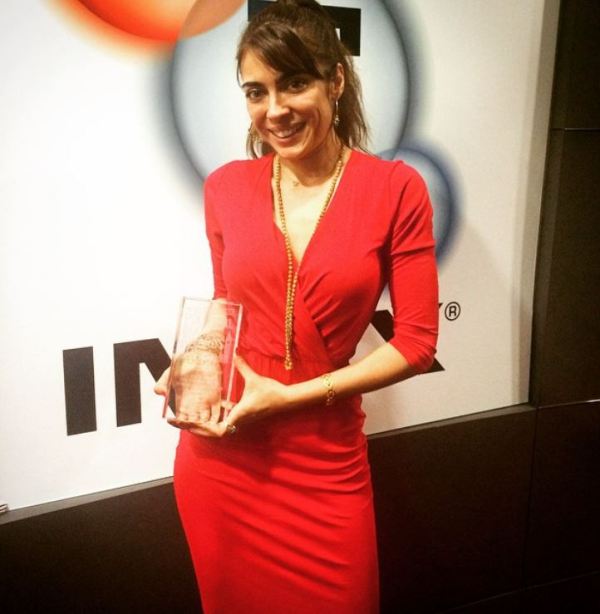
Ramita Navai holding the ‘Debut Political Book of the Year Award’ at The Political Book Awards for her book ‘City of Lies: Love, Sex, Death, and the Search for Truth in Tehran’
Shifting Sands: The Unravelling of the Old Order in the Middle East (2015)
Ramita Navai has co-authored the book ‘Shifting Sands: The Unravelling of the Old Order in the Middle East.’ [92]Ramita Navai – LinkedIn Ramita Navai, along with fifteen other contributing authors, has written about the Middle East and the after-effects of World War-I concerning Egypt, Iran, and Syria. Ramita has written the chapter ‘Iran: Coming in from the Cold?’ for the book. [93]Ramita Navai – LinkedIn
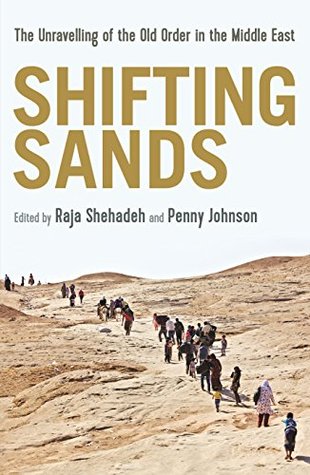
Raja Shehadeh and Penny Johnson’s ‘Shifting Sands The Unravelling of the Old Order in the Middle East’ – co-authored by Ramita Navai and others
Awards, Honours, Achievements
- In 2012, Ramita won the 33rd Annual News & Documentary Emmy Award under the category of Outstanding Coverage of a Breaking News Story in a News Magazine [94]Quicksilver Media for her documentary ‘Syria Undercover.’ [95]Ramita Navai
- In 2015, her documentary titled ‘Migrant Crises: Tracking Down the Refugee Kidnap Gangs’ won many awards including the “Foreign Press Association Award – TV News Story of the Year,” and the “Royal Television Society Award (The Independent Award).” [96]Ramita Navai – LinkedIn
- In 2017, Ramita’s documentary ‘Iraq Uncovered’ won the “Robert F. Kennedy Award for Television Journalism.” [97]Ramita Navai – LinkedIn
- A documentary titled ‘ISIS and the Battle for Iraq Dispatches’ by Ramita Navai won “British Journalism Awards: Foreign Affairs Journalism” and “The Frontline Club: Broadcast Journalism Award” in 2018.
- Ramita Navai’s documentary on the ‘UN Sex Abuse Scandal’ won “Robert F. Kennedy Award for Television Journalism” in 2019. [98]Ramita Navai – LinkedIn
Facts/Trivia
- According to Ramita, after the Iranian government banned her press card for writing two articles against the Iranian government, she started volunteering as a teacher in a school run by an NGO in South Tehran, where children belonged to different backgrounds such as children of migrants, prostitutes, and gipsies. [99]Jaipur Literature Festival
- According to Ramita, she was asked to pose as ‘Frida Kahlo,’ a famous Mexican painter known for her self portrays of the themes of identity, the human body, and death by a photographer of wide-ranging skills Lesley Howling. According to Ramita, she posed for Lesly Howling many times. [100]Ramita Navai – Instagram
- According to Ramita Navai, the most memorable moment that changed her career was the massive earthquake in Iran. [101]Aurra Studios – YouTube According to her, this was the first big story covered by her. [102]Aurra Studios – YouTube She said,
The moment that changed my career and changed the course of my life was the first big story I ever did and it was a massive earthquake in Iran, in the south of Iran called Bam. I was one of the first western journalists along with two friends to get there and we were totally unprepared for what we saw which was tens of thousands of dead bodies. People have lined up their dead in the street and when we got to Bam there were no rescue services there. The scene was post-apocalyptic and people were in shock and there was an eerie deadly silence as we drove into this desert town that had been absolutely ruined and all around us we could see was people quietly scrabbling in the ruins of their homes to try and dig out loved ones who are still under the rubble. It was the first time I was writing for a newspaper and it was the first time that I was dealing with just a horrific event unfolding in front of my eyes and that will stay with me forever.” [103]Aurra Studios – YouTube
References

